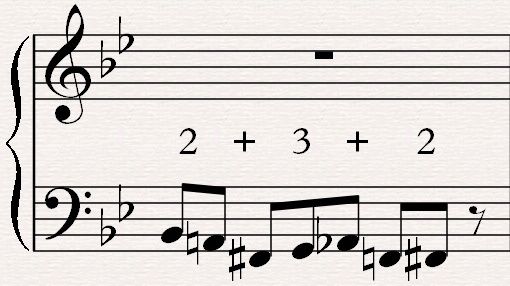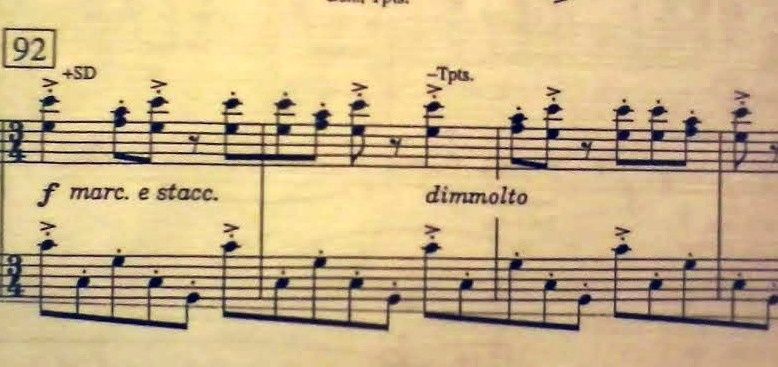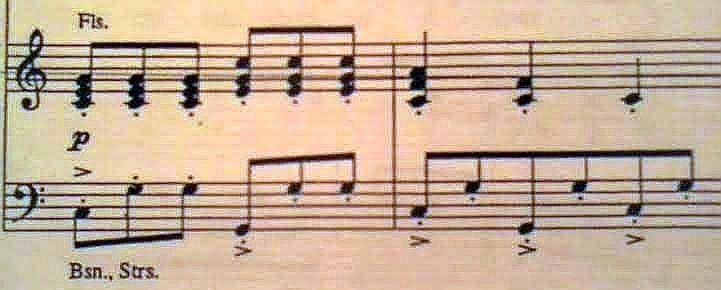Part 2
This post is part of a multi-part blog series I'm calling "West Side Score-y" (A Score Study of West Side Story). Part 1 addressed something I called the "Smush Chord." This second post will delve (excessively?) into the nitty-gritty of what makes Bernstein's music so rhythmically engaging.The West Side Story score is rife with rhythmic riches, so to avoid being overly ambitious, I will focus here on 3 big ideas:
- Syncopation
- Polymeter
- Hemiola
To do so, I'll share some song excerpts and discuss their relation to one (or more) of the above concepts. (All right, here we go!)
1. Syncopation: It's where you'd least expect it.
Syncopation can basically be described as a rhythmic device in which notes are placed in unusual, unexpected spots within the bar. For example, instead of quarter notes on beats 1 and 3 (so-called "strong" parts of the measure), moving these quarter notes instead to 2 and 4 (the weaker "off-beats" of the bar) would result in a syncopated feel. This version of syncopation, in which 2 and 4 are emphasized instead of 1 and 3, is the foundation of jazz and rock grooves.
Another way to achieve syncopation is to shift a note slightly within a measure, from its usual spot to a less-expected spot. Take a look at this excerpt from "Jet Song":
The time signature here is 6/8, which is a compound duple type of meter. This means that there are 2 main beats (duple) and each of these beats can be further divided into 3 (compound). This being the case, the notes which fall on the main beats are considered strong, and those which do not are weak in comparison.
In this example, the right hand is playing on weak off-beats, just an eighth note earlier than the left hand's strong-beat notes. This gives the song a slightly off-kilter, swinging feel. Cool!
*Note 1: Good examples of syncopation are in just about every measure of Lenny's score. That is to say, most bars of Bernstein's music are syncopated.
*Note 2: Do not confuse "Bernstein bars" with the ursine children's book series by a similar name. I apologize for this joke.
*Note 3: All three of these italicized Notes were added SOLELY for the delivery of that awesome joke and are of ZERO educational value.
2. Polymeter: 2+ meters for the price of 1.
A polymeter (not to be confused with polyrhythm) is exactly what you think it means: literally, "many meters." In a polymetric piece of music, the beat is constant between the two meters (but each meter's measure size differ, resulting in periods of de-synchronization).
It's what's happening when your band is playing in 4/4, but at the same time, your goofball drummer is for some reason playing in 7/8. (We'll give him the benefit of the doubt here in that he's not just leaving notes out willy-nilly, but rather is showing off his polymetric powers...)
It's what's happening when your band is playing in 4/4, but at the same time, your goofball drummer is for some reason playing in 7/8. (We'll give him the benefit of the doubt here in that he's not just leaving notes out willy-nilly, but rather is showing off his polymetric powers...)
Although it might happen accidentally in your garage band, Bernstein uses it intentionally—and to great effect—all over West Side. That is to say, there are many polymeters (poly-polymeters?)
Example 2A: "Scherzo"
This scherzo is written primarily in 3/4, though it actually reeks of 5/8 (or 5/4, depending on your math) for much of its duration. Since we've got 5/8 and 3/4 going on simultaneously, we can say that we're dealing with polymeter here.
It's not a bad idea to do some arithmetic in such polymetric cases, to see how many repetitions of the odd time signature it takes to line back up with the primary meter. In this case we consider 5 eighth notes (from 5/8) and 6 eighth notes (from 3/4). Least common multiple = 30 eighth notes, meaning it will take 15 quarter notes (five bars of 3/4) before the first note of the pattern falls on the original downbeat again. (And this is precisely how Bernstein divides his beats in the scherzo. It all adds up, phew!)
Example 2B: "Prologue" bass line
This one's groovy. Here we have a bass line in 7/8 placed over a 2/4 meter. Essentially, it's just one eighth note away from being the bass line you would expect. So close.
The effect of this is two-fold: 1) The position of the accented first note of the pattern gets constantly shifted to the left (earlier) on each successive measure. That's pretty neat. 2) It's kind of gnarly to get your left hand to play it when your right hand is simultaneously playing syncopated stuff in the original 2/4 meter. Gnarly, but not impossible.

In order to solidify the pattern, both intellectually and physically, I broke the 7 notes into smaller groups (based on their chromatic proximity with nearby notes). That made it much easier to manage. From there I could go ahead and add in the right hand and begin thinking of the longer lines.
To see this longer line, I'm once again referring to the pattern being repeated x number of times, 'til the pattern's first note once again falls on the 2/4 bar's downbeat. In this case, it takes 7 repetitions. Here's half of that (click to enlarge):
3. Hemiola: Not a scary blood disease.
The word hemiola represents the ratio of 3:2. With respect to rhythm, this ratio occurs by way of grouping 6 notes either in three groups of 2 or two groups of 3. An oft-cited example of this rhythmic hemiola is from none other than "America."
The song alternates between compound duple (6/8) and simple triple (3/4) meters. I'll spare you any more needless math. The sheet music, I think, shows the alternating groupings rather clearly.
Conclusion
The big takeaway? Heck, I dunno.
- You can always "count" (HAH) on Bernstein to jam-pack his music with rhythmically rich stuff. Lenny's got rhythm, indeed. And now you do, too.
- Don't let the math of it put you off. Once you understand the basic numbers/groupings of a meter, you will easily be able to switch on a sort of "rhythmic auto-pilot." This is when you can freely and enjoyably just let the music happen.
- Remember that "Bernstein Bars" joke? That was pretty funny.






No comments:
Post a Comment